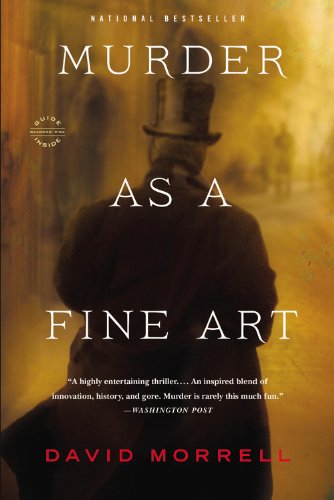Murder as a Fine Art (Thomas and Emily De Quincey, 1) / Morrell, David
| List Price: | |
Our Price: $17.99 | |
|
For Bulk orders
| |
|
Used Book Price: | |
| Murder as a Fine Art (Thomas and Emily De Quincey, 1) / Morrell, David | |
| Publisher: Mulholland Books | |
| Availability:In Stock. | |
| Sales Rank: 159276 | |
|
Illustrations for Murder as a Fine Art


A Review by Katherine Neville
NY Times and #1 international bestseller Katherine Neville has been referred to as "the female" Umberto Eco, Alexandre Dumas, and Stephen Spielberg. Her adventure-packed Quest novels have been called a "feminist answer to Raiders of the Lost Ark," (Washington Post) and were credited with having "paved the way for books like The Da Vinci Code" (Publishers Weekly).
At first glance, Murder as a Fine Art--a jewel-like, meticulously-crafted historic detective story, set in the high-Raj period of Victorian England--might seem a complete departure for the king of the Thriller genre and "father of Rambo." It takes a tremendous commitment, not to mention a bit of a risk, for a writer like David Morrell, at the pinnacle of a long and successful career, to decide to create a work in a very different genre.
Morrell's secret weapon, which for decades has placed him at the very forefront of suspense writers, has always been his use of impeccable hands-on research: he has honed the art of seamlessly interweaving rich troves of fascinating detail into his plot lines and character sketches, so that we readers never feel--as so often happens with background research found in fiction--that we are being subjected to a tutorial.
Part of the reason Morrell's research has always paid off so well in his previous works has been his relentless quest to learn and master many of the skills he was writing about: flying the airplanes, loading the weapons, earning the black belts. He has rehearsed his characters' skills much as an actor rehearses a character role. But in Murder as a Fine Art, how would he accomplish this, when the story is set in the 1850s, and his main protagonists are a young woman who is self-liberated from Victorian constraints, including her corset!--and her father, a notorious opium addict! He accomplishes it, and brilliantly, by steeping himself so thoroughly in the context of nineteenth century London that, in his own words, he became "a Method actor," guiding us through the London fog (I never knew it was filled with charcoal!)--while acting out in his mind the roles of these real historic figures.
The "Opium Eater" himself, our lead character, was author Thomas de Quincey, a friend of Wordsworth and Coleridge who wrote thousands of pages that today largely have been forgotten. But his most infamous book of the day, and one that has long outlived him, Confessions of an English Opium-Eater, was so scandalous that it topped the charts of that era and was preached against (perhaps with good cause) in the churches. De Quincy helped spawn the school of "sensationalist" literature, with his memoirs and essays influencing fiction writers from Wilkie Collins to Edgar Allan Poe to Arthur Conan Doyle.
Morrell has chosen to open his novel in 1854 because that date marks the publication of the final installment of de Quincey's equally shocking three-part essay: "On Murder Considered as One of the Fine Arts," a lurid and gory description with pre-Freudian overtones, of East End murders that took place more than forty years before our story begins. The novel opens with de Quincey arriving in London for his essay's publication, accompanied by his daughter Emily, to learn that he himself is suddenly the prime suspect in a murder that precisely replicates those decades-old killings he'd so lavishly described in his book.
This wonderful set-up provides the real historic character, Thomas de Quincey, with the fictional opportunity to match his laudanum-enhanced wits against the villain's, while simultaneously utilizing his vast learning about the first crimes, and his personal understanding of the subconscious and sublimation, in aiding the police to solve the actual crimes. It doesn't hurt that Morrell's own vast learning enlightens us along the way, with asides on little known Victoriana, covering everything from the gutters, sewers and cesspools of the seamy side of London, to the highest echelons (equally seamy) of British political and bureaucratic corruption.
In fleshing out this era for us, Morrell has deployed one of the favorite Victorian novelistic vehicles: an omniscient narrator who can fill us in on "back story" contexts and details--everything from the vast panorama of the the Opium Wars between Britain and China, to fascinating minutiae like the 37-pound costumes that women wore daily, made of yards of fabric over whalebone hoops and corsetry. There is something about using this particular literary technique, in a book like this, that rings truer than a straight narrative because it is a storytelling style so accepted that it appears in nearly every novel of the period. Perhaps for Morrell's use of this particular method of reportage, Murder as a Fine Art has been compared with recent books that are set in the past, like The Dante Club and The Alienist; I would add that it also brings to mind another tour de force: the stunning literary footwork of an author who lured us into another alien era with equal mastery and success: John Fowles in The French Lieutenant's Woman.
But my personal favorite in Murder as a Fine Art is the character of Emily de Quincey. Who could not cherish a girl who can shed her whalebone cinches and don a pair of bloomers so she can dash down streets and leap gutters alongside the London constabulary? A girl with the wits to mess up her hair, rip open her bodice, and stagger into an angry mob that's threatening her police escort, and to divert the rabble to her imaginary "attacker" at the opposite end of the alley? Emily repeatedly saves the day by paying attention to the people around her, their needs and desires; by grasping how the context of their lives alters the roles they are able to play in it; by using her wits and her common sense as a complement to her father's brilliant, if drug-induced, vision.
The vicious psychotic killer may have been thwarted this time around, but I suspect that Emily de Quincey's services will still be needed to keep London streets safe from other threats creeping out of the dank London fog, in future: I vote for a sequel, Mr Morrell!
Now you can buy Books online in USA,UK, India and more than 100 countries.
*Terms and Conditions apply
Disclaimer: All product data on this page belongs to
 .
.No guarantees are made as to accuracy of prices and information.










